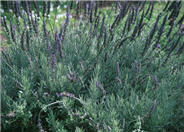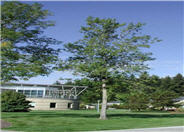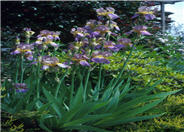
Common name:Hybrid Tea Rose cultivar
Botanical name:Rosa Hybrid Tea selection
Hybrid tea roses are the traditional classic roses; buds are used for boutonnieres. These roses have long stems with a single rose at the end, which may or may not be fragrant. Blooms typically start in spring until fall. Many colors now available. Roses prefer full to part sun with well draining, rich soil. It needs fertilizer after each bloom period. It prefers medium watering and more in hot summer areas. Mulch well. Prune in winter. It usually grows 2'-6' tall.

Common name:Goodwin Creek Grey Lavender
Botanical name:Lavandula 'Goodwin Creek Grey'
Lavandula 'Goodwin Creek Gray' is an evergreen shrub. This dense foliaged plant grows to 2.5'-3' high and 3'-4' wide, with silvery leaves that are toothed at the tips. Deep violet-blue flowers from spring to late fall.

Common name:Oregon Ash
Botanical name:Fraxinus latifolia
Oregon Ash is a deciduous tree that grows slowly, reaching 25' in 10 years. Leaves are made of leaflets, turning yellow or brown in fall. Small green or yellow flowers bloom in spring, before leaves appear. Flowers are considered inconspicuous. This tree prefers full sun with fertile, moist, well draining soil.

Common name:Bearded Iris
Botanical name:Iris Bearded Hybrids
This perennial will grow 1'-3' tall and has medium sized, blue green leaves with flowers of different colors that bloom in spring. It needs well draining soil and full sun. Many are fragrant and rebloom in the fall. Plant rhizomes in Sept or Oct. They need water once a week during the hot spells. Top dress with compost and gypsum in January and August.
| Designer: Susan Stiltz | Winding Pathway |
Photographer: GardenSoft |
Soils and Compost:
Physical weed control, including mulching, or hand removal protects the watershed from harmful chemicals.
Water Saving Tip:
Apply as little fertilizer as possible.
If you use fertilizer make sure it stays on the landscape, and carefully water it in so there is NO runoff.
Integrated Pest Management:
Drip and other smart irrigation delivers water directly to roots, allowing no excess water for weeds.
